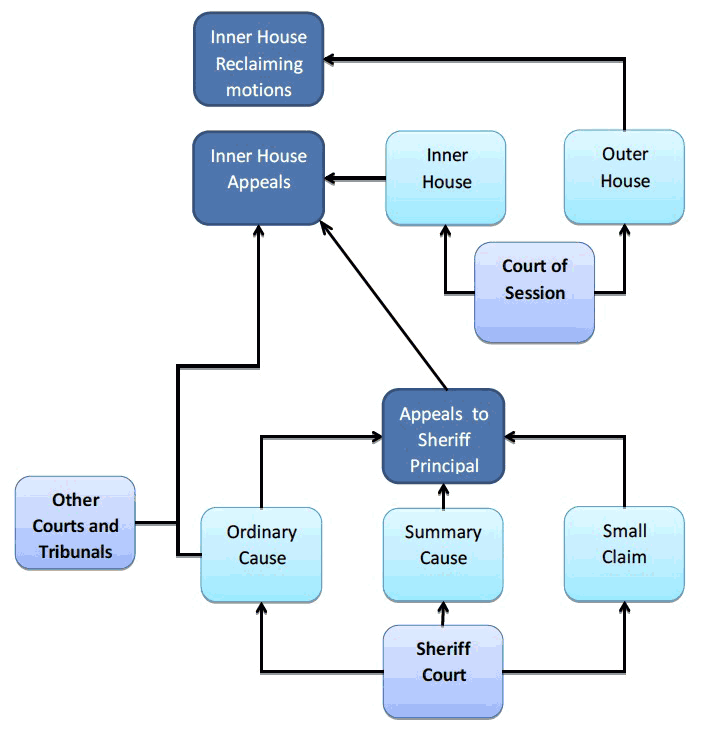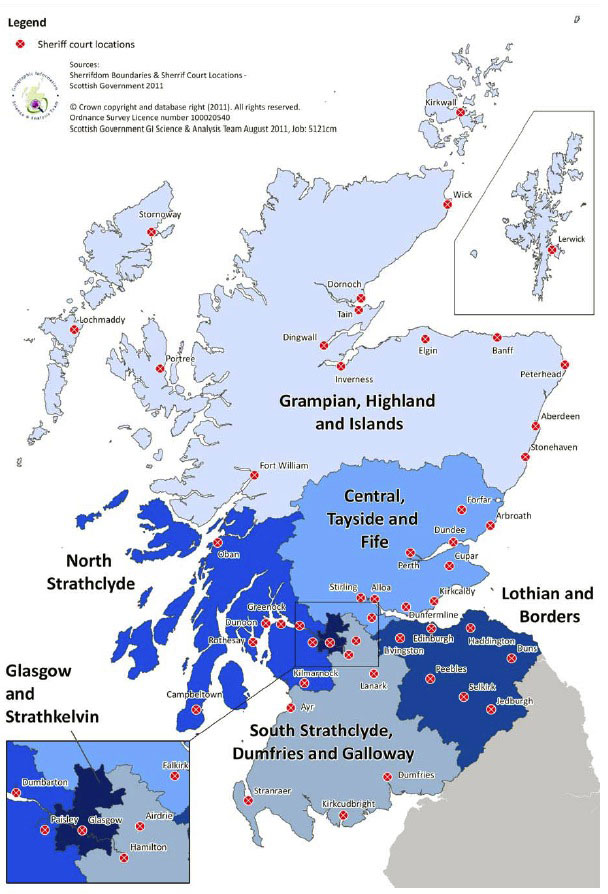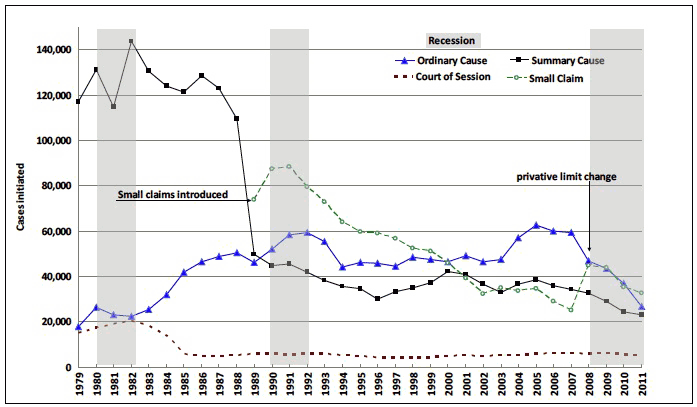Civil justice statistics in Scotland: 2011-2012
Civil Law Statistics in Scotland 2011-12 provides
information about cases which have gone through the civil courts in Scotland.
together with some wider, contextual information about the extent of civil
problems in Scotland.
This document is part of a collection
2. An outline of the court structure in Scotland
Figure 1: Summary of court structure

Court of Session
2.1 The Court of Session is the highest civil court in Scotland. There are three departments within the Court of Session:
- The General Department, which deals mainly with cases where one person wants to enforce a legal right against another. The General Department deals with a variety of case types, including: personal injury, family, damages, interdict, intellectual property, debt and commercial;
- The Petition Department, which deals with cases where the authority of the court is sought to deal with a variety of legal issues, other than disputes between people or organisations; and
- The Inner House and Extracts Department, which deals with all cases proceeding before the Inner House and the issue of extracts, which are official court documents allowing judgments of the court to be enforced.
2.2 Cases are heard either in the Outer House or the Inner House. The Outer House is where the majority of cases are first heard. In this court, single judges normally preside over cases. The Inner House deals primarily with appeals, although it does hear a small amount of first instance business. At least three judges sit to hear cases in this court, except where the business is procedural in nature when a single judge may sit for most classes of appeal.
2.3 Appeals from the Outer House of the Court of Session, known as reclaiming motions, are made to the Inner House;
2.4 The Inner House also hears appeals from the sheriff courts and certain tribunals and other bodies.
2.5 Appeals against judgments of the Inner House of the Court of Session may be made to the Supreme Court of the United Kingdom, which was established on 1 October 2009 and replaced the House of Lords in its judicial capacity. There is normally no requirement to obtain the Court of Session's permission, or leave, to appeal to the UK Supreme Court. Statistics on appeals from the Court of Session to the UK Supreme Court are not contained within this publication.
Sheriff Courts
2.6 Sheriff courts are local courts of civil jurisdiction in Scotland. They also have jurisdiction in criminal proceedings. There are 49 sheriff courts, which are grouped into six sheriffdoms. Each sheriffdom has a sheriff principal - a senior judicial officer who hears appeals in civil matters, determines certain types of inquiry, performs statutory administrative functions and also has responsibility for the effective and efficient disposal of business in the sheriff and Justice of the Peace courts within the sheriffdom. Most cases are heard before a sheriff.
2.7 Most civil business involves disputes between people or organisations, which are carried out under one of three procedures:
- Ordinary cause - This procedure is used where the case involves any monetary claim over £5,000, for cases involving family disputes or for many other cases where more complex legal issues arise.
- Summary cause - This procedure is used where the case involves any monetary claim over £3,000 and up to (and including) £5,000. It is also used for the recovery of rented property, for recovery of moveable property and for personal injury cases up to (and including) £5,000.
- Small claims - This is intended to be a relatively informal procedure for resolving disputes, which is used where the case involves any monetary claim up to (and including) £3,000, except where the claim relates to aliment, defamation or personal injury.
2.8 Other civil business in the sheriff courts involves applications which are made mainly under statutes (Acts of Parliament) and are carried out under summary application procedure, so-called because these applications can be disposed of in a brief and informal (or summary) manner.
2.9 The sheriff courts also deal with commissary business relating to succession and access to a deceased person's estate. Commissary work mainly involves issuing confirmations, which are legal documents sometimes required by organisations, such as banks, before they can release money and other property belonging to someone who has died.
2.10 Appeals of civil cases which have been disposed in the sheriff courts can be made to the sheriff principal or the Inner House of the Court of Session:
- small claim appeals must be made to the sheriff principal, whose decision is final;
- summary cause appeals must also be made to the sheriff principal in the first instance, but the judgment of the sheriff principal may, if they certify the case as suitable, be appealed to the Inner House of the Court of Session;
- ordinary cause appellants may in some circumstances choose to appeal to either the sheriff principal or the Court of Session, and where the case is appealed to the sheriff principal, it may in some circumstances be further appealed to the Court of Session.
Figure 2: Location of the sheriff courts in Scotland

Historical Time Series
2.11 Figure 3 shows how the volume of civil court cases has changed in Scotland over the last thirty years. The number of cases initiated in the Court of Session has varied between 4,000 and 6,000 since the mid-1980s.
Figure 3: Historical timeseries 1979 - 2011

2.12 There has been greater fluctuation in the volume of cases initiated in the sheriff courts. The volume of summary cause cases reduced substantially in 1989 and, since then, has exhibited a broadly downward trend. This sudden decrease was due to the introduction of the small claims procedure which was designed to make the court process easier and less formal for people making low value claims (originally up to and including £750). Consequently, considerably fewer people had to use summary cause procedure which, until then, had been the least formal procedure available in the sheriff courts.
2.13 The number of small claims cases briefly increased following the procedure's introduction but subsequently decreased until 2008, when the privative jurisdiction of various sheriff court procedures were increased. Small claims can now be made up to and including the value of £3000 which has led to an increase in the number of cases initiated using this procedure. The number of cases initiated under ordinary cause procedure exhibited an increasing trend, but has been declining since it peaked in 2005. There was a sudden decrease between 2007 and 2008 which is likely to have been a result of the privative limit increasing to above £5000 and a further decrease during 2011 which seems to be caused by the effects of the Home Owner and Debtor Protection (Scotland) Act 2010.
2.14 Overall, the total number of cases going through the civil courts has been decreasing since the early 1990s and fell below 100,000 for the first time in 2010.
Recent Civil Legislation Changes
2.15 The Home Owner and Debtor Protection (Scotland) Act 2010 came into force on 30 September 2010. This Act included a change to the way that repossession cases relating to mortgages and loans related to residential property are raised in court - these are now being raised as summary applications. Previously, nearly all court actions for repossession were made under ordinary cause procedure.
2.16 The figures for court actions relating to repossessions are also affected by the UK Supreme Court judgment in the RBS v Wilson case, issued on 24 November 2010. This resulted in all repossession cases being withdrawn from the courts and resubmitted as summary applications following the completion of the two month waiting period required by the judgment. The statistics for court actions relating to repossessions are likely to be skewed for a few months from December 2010 onwards as a result.
2.17 The figures for asbestos-related pleural plaques in 2008-09 were affected by the impact of a House of Lords decision in October 2007, which upheld a majority decision of the Court of Appeal in England (and which was not binding on the courts of Scotland) that the existence of pleural plaques did not constitute actionable damage[1].
2.18 The subsequent increase in asbestos-related pleural plaques in 2009-10 was mainly due to the Damages (Asbestos-related Conditions) (Scotland) Act 2009, which came into force in June 2009 and allows individuals with asbestos-related pleural plaques etc. to raise a court case for personal injury. There have been relatively few disposals of these cases, as many were sisted (suspended) pending the UK Supreme Court's decision as regards a petition challenging the validity of the legislation which was lodged on behalf of a consortium of insurers[2]. That challenge was successfully defended in the Outer House, Inner House and the Supreme Court in January 2010, April 2011 and October 2011 respectively.
Contact
Email: Howard Hooper
There is a problem
Thanks for your feedback